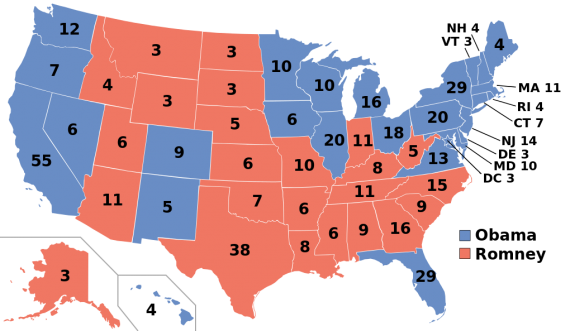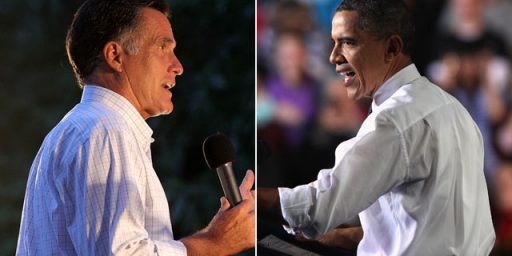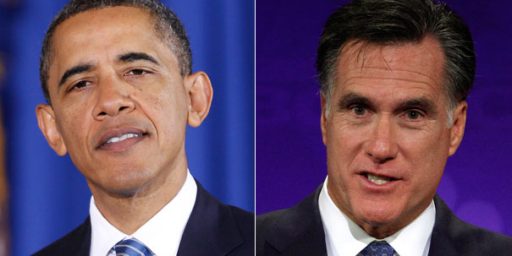The 2016 Electoral College Battlefield Is Very Small
The 2016 election will be fought on a very small battlefield, and right now the makeup of that battlefield heavily favors the Democrats.
Eric Ostermeier at Smart Politics writes about the result of a study that reviewed every Presidential election since 1828 and found that, at most, there are 14 states that are likely to be competitive in the 2016 election:
The 2012 presidential map recorded the lowest ever rate of statewide cycle-to-cycle partisan change in the two-party era and the nation is also currently in the midst of its lowest rates of change in its electoral maps across the last three-, four-, five-, six-, seven-, eight-, and nine-cycle periods.
With historically few states flipping back and forth between their partisan preferences in presidential races, political parties are starting to rack up an impressive array of statewide winning streaks as a result.
Thirty-six of them, to be precise.
Smart Politics examined the 2,000 statewide elections for president conducted since 1828 and found that 36 states are currently in the midst of their longest ever Democratic or Republican winning streaks with the GOP enjoying its best ever runs in 20 states and Democrats at peak levels in 16 others.
Republicans have notched their longest winning streaks in states across three regions of the country – in the Midwest (Kansas, Missouri, Nebraska, North Dakota, South Dakota), the South (Alabama, Arkansas, Georgia, Kentucky, Louisiana, Mississippi, Oklahoma, South Carolina, Tennessee, Texas, West Virginia), and the West (Alaska, Idaho, Utah, Wyoming).
Democrats have done the same in the Northeast (Connecticut, Delaware, Maine, Massachusetts, New Jersey, New York, Pennsylvania, Rhode Island, Vermont), the Midwest (Michigan, Minnesota, Wisconsin), and the West (California, Hawaii, Oregon, Washington).
While a few of these states are often considered bona fide (Pennsylvania, Wisconsin) or quasi- (Michigan, Oregon, Washington) battlegrounds each cycle, a substantial number of Electoral College votes are currently held in states where one of the two major parties is enjoying unprecedented success at the ballot box.
For the GOP, these 20 reliably GOP states take 166 electoral votes off the table each cycle while the 16 Democratic states have given its nominees 209 electoral votes on which they can count (212 if one counts the District of Columbia which has never voted for a Republican nominee).
None of this is terribly, surprising, of course. Every Presidential election year there are a large portion of states that are clearly going to go for either the Republican or the Democratic candidates. The only time that hasn’t been the case has been when we have seen landslides on the scale of Ronald Reagan’s victories in 1980 and 1984, or in years where there has been an particularly strong third-party candidate, as we saw in 1992 and 1996. For the most part, Presidential elections, especially over the past fifteen years, have been fought in a very small battlefield. In the 2000 election, of course, that battlefield essentially consisted of the Florida, but the course of the election could have also been changed by different results in Ohio and Virginia. The electoral lock that Ostermeier talks about also played a role in that election because Gore’s failure to win in his home state of Tennessee, one of the states on Ostermeier’s list as a long-term GOP lock, cost him the election. Had he won in Tennessee, Gore would have been President regardless of what happened with the hanging chads in Florida. The restricted battlefield was also on display in the 2004, 2008, and 2012 elections, all of which essentially came down to what happened in a handful of states, with Ohio, Florida, and Virginia playing the most important roles.
As we start looking ahead to 2016, it’s important to keep these Electoral College issues in mind as we look at the state of the race. Political pundits, bloggers and cable news networks have breathlessly reported the release of each new head-to-head poll between Hillary Clinton and her potential Republican rivals, including a new poll that purports to show Hillary Clinton trailing Donald Trump. However, these polls are essentially meaningless at this point in time. For one thing, we’re still fifteen months away from the General Election, and ten months from the time when the General Election campaign effectively begins with the conclusion of the Republican and Democratic National Conventions. There is simply too much that can happen between now and then that will affect the election for any polling to be reliable. At this point during the 2012 cycle, President Obama was seemingly in trouble in Virginia where he had won in 2008, and losing to a “Generic Republican” candidate in a head-to-head matchup. In addition to the problems with head-to-head polling at this point in the election, the fact that Presidential election are decided at the state level rather than nationally means that the polling really misses what the race is about. It is admittedly rare that a candidate will win the Electoral College and lose the popular vote, but it has happened before and could happen again. At the very least, though, it means that head-to-head polling, especially this early in the race, is not a good predictor of how an election will turn out.
Looking ahead to 2016, it’s obvious that Ostermeier’s electoral locks will largely be in place. Absent a wave election, which is unlikely, Democrats aren’t going to win many or any of the states that have become traditionally Republican, and Republicans are not going to win in traditionally Democratic states. Instead, the race is likely to come down to handful of states, specifically Ohio, Virginia, Florida, New Hampshire, Colorado, and Nevada. In this environment, it is the Republican candidate that will looks to have the toughest battle. Republicans haven’t won in New Hampshire since 2000, for example, and haven’t won in the remaining states since 2004. In order to win in 2016, the Republican candidate will need to win all of the states that Mitt Romney did in 2012 along with Florida, Virginia, Ohio plus one other state. The Democratic candidate, on the other hand, could afford to lose several of the states that President Obama did in 2012 and still win the election. They could even afford to lose Ohio, Florida, and Virginia and still win narrowly, but obviously if that happened they would likely be in trouble in several other states that the President had previously won. In either scenario, though, it is clear that at the moment the Electoral College battlefield heavily favors the Democrats, and unless that changes the GOP will be locked out of the White House yet again.







The southern strategy fail.
We’ll hold Virginia regardless of the GOP candidate. We’ll hold Ohio unless Kasich gets the nom. I’m a bit nervous about Colorado with legalized pot no longer on the ballot.
I used to worry that we’d lose Florida. But in the latest Florida poll, Jeb is in third place, well behind Trump and Carson. In fact, add the two Floridians, Jeb and Rubio together, and they have less in total than Ben Carson, let alone Trump. And that does not spell certain Florida defeat for Democrats.
Also, the demographics are shifting a bit in the potential Florida vote:
For Florida that’s a pretty wide margin. How well will GOP voter-suppression work? Can we keep the Hispanic vote engaged if Trump drops out?
@michael reynolds: The Republicans are losing the demographic war and they know it. Hence you see attempts at voter suppression.. The tea party is a response to these changing demographics.
Nice use of the passive voice. It’s not that the Republicans are at a disadvantage because of anything structural, they are at a disadvantage because their policies are repugnant and their candidates are offensive. They aren’t being locked out, they are locking themselves out.
The Republicans might not only have a tough time electorally in Colorado, but procedurally as well. They canceled their April straw poll to “unbind” their votes for the convention. That means the meetings won’t be as raucous and no Republican candidate will be spend any resources here. Decreasing interest levels lead to decreased voter turnout, increasing the chances of a Democratic win.
Apparently the reasoning behind this was a misinterpretation of RNC rules. (They were worried about binding their votes to a candidate who was out of the race by convention time.) But what are they gonna do about it? The chairman of the state party is a moderate pulling on the brakes, but he’s also an incompetent goofball.
A couple more cycles like this and we won’t be one of the battleground states anymore. We’ll just be blue.
I have a bete noire. These geographical maps do a poor job of telling the story of political affiliation. Montana is smaller, much smaller, than Illinois. I promise to make this plea only once a year.
@James Pearce:
Thanks for the insight on Colorado. That is good news.
@Slugger:
It’s by virtue of very few people living there that those western red state manage to stay red.
I think a strong argument can be made for Georgia being competitive in 2016. Chris Ladd over at GOPLifer has written about this.
One huge concern for Democrats is some polls suggesting voter erosion in Pennsylvania and Michigan, especially with Clinton. George Wallace was once able to win the primary in Michigan, suggesting that Donald Trump’s “angry white man” message and demeanor may play better in this normally blue state than many may realize. I’m less certain why the Pennsylvania polls have not been as good for Democrats here as usual.
@Paul Hooson:
Every four years the Republicans decide Pennsylvania’s in play. Every four years it isn’t.
@michael reynolds: As long as the Democrat can run close to or ahead of the Republican in the national polls, Pennsylvania will be pulled along in the Democratic column. It has been inclined to lean Democratic for sure. John Kerry proved a Democrat can run two points behind the Republican nationally and still pull Pennsylvania along.
As long as PA has Philidelphia and Pittsburgh the GOP has no chance if winning.
I also think VS is gone and while NH is notorious for fitting back and forth I don’t think the GOP takes the state.
I think the more interesting question is whether the voters who turned out for Obama will turn out for Hillary (or whoever wins the nomination if Hillary doesn’t).
VS=VA fat fingers and phone to blame.
Presidential elections don’t have to continue to be dominated by and determined by a handful of swing states.
The National Popular Vote bill would guarantee the presidency to the candidate who receives the most popular votes in the country.
Every vote, everywhere, would be politically relevant and equal in presidential elections. No more distorting and divisive red and blue state maps of easily pre-determined outcomes. There would no longer be a handful of ‘battleground’ states where voters and policies are more important than those of the voters in 80% of the states that now are just ‘spectators’ and ignored after the conventions.
The bill would take effect when enacted by states with a majority of Electoral College votes—that is, enough to elect a President (270 of 538). The candidate receiving the most popular votes from all 50 states (and DC) would get all the 270+ electoral votes of the enacting states.
The bill has passed 33 state legislative chambers in 22 rural, small, medium, large, red, blue, and purple states with 250 electoral votes. The bill has been enacted by 11 jurisdictions with 165 electoral votes – 61% of the 270 necessary to go into effect.
NationalPopularVote.com